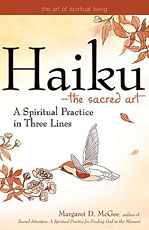Margaret D. McGee is a writer, teacher, a leader of spiritual workshops and retreats, and the author of Sacred Attention: A Spiritual Practice for Finding God in the Moment. She wrote her first haiku when she was 45. She loves this sacred art which comes to the fore "when the mind stops and the heart moves." McGee notes that although haiku has a long and illustrious tradition in Japan where Shinto and Buddhism are the two main religions, it serves "a human longing that lies deep within all faith traditions: the need to find our place in the world, to feel in our hearts our relationship to each other and to all of creation." In this volume in SkyLight Path's The Art of Spiritual Living series, the author demonstrates the many uses of this art form and the riches that it can bring to our appreciation of the world around us and everyday spirituality.
A haiku, says McGree, "expresses the heart of a moment" in three lines. Here are a few examples:
the distant mountain
reflected in his eyes . . .
dragonfly
— Kobayashi Issa (1762-1826)
weeding —
on my knees
as the earth turns
— Dee Baker
spring wind —
I too
am dust
— Patricia Donegan
All three are good examples of the way this art form offers a moment of recognition and a chance to honor the special qualities of something or someone who shows up in our lives. A haiku honors the fleetingness of experience and provides us with opportunities to be connoisseurs of the commonplace. Or as R. H. Blyth once put it: "Haiku are an expression of the joy of our reunion with things from which we have been parted by self-consciousness."
McGee lists list four traits of this type of poetry: a haiku is brief, it uses images to talk about everyday things, it has an open feeling, and it shows us things as they are. Haiku are especially keen in helping us see "how the seasons of nature can bring the universal and the personal together in a moment that evokes vivid feeling."
McGee has some very interesting things to say about using haiku in conjunction with sacred places, texts, communities, pictures, and prose. Throughout this paperback, she provides exercises and spiritual practices to encourage your haiku art.
